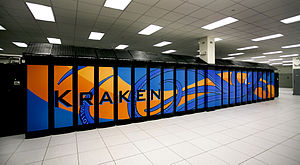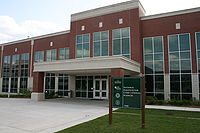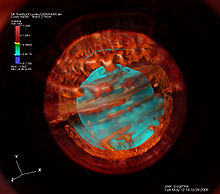- National Institute for Computational Sciences
-
The National Institute for Computational Sciences (NICS) is funded by the National Science Foundation and managed by the University of Tennessee. NICS is home to Kraken, the most powerful computer in the world managed by academia and the world's fourth overall most powerful supercomputer.[1] The NICS petascale scientific computing environment is housed at Oak Ridge National Laboratory (ORNL), home to the world's most powerful computing complex. The mission of NICS, a TeraGrid member, is to enable the scientific discoveries of researchers nationwide by providing leading-edge computational resources, together with support for their effective use, and leveraging extensive partnership opportunities.
Contents
Systems
Kraken
 Kraken, a TeraGrid resource that is currently the world's fastest academic supercomputer and 3rd fastest computer on the November 2009 Top500 list.[2] Kraken is funded by the National Science Foundation and managed by the University of Tennessee.
Kraken, a TeraGrid resource that is currently the world's fastest academic supercomputer and 3rd fastest computer on the November 2009 Top500 list.[2] Kraken is funded by the National Science Foundation and managed by the University of Tennessee.
Kraken is a petascale computing environment fully integrated with the TeraGrid with access to the 1.03-petaflop Cray XT5 system containing 16,512 compute sockets and more than 129 terabytes of memory. In November 2009, it was named the third fastest computer in the world.[2] In its final configuration, the XT5 system will deliver in excess of 700 million CPU hours per year. The system is designed specifically for sustained application performance, scalability, reliability and will incorporate key elements of the Cray Cascade system to prepare the user community for sustained, high-productivity petascale science and engineering. The NSF computer system is co-located with the National Center for Computational Sciences, home of Jaguar, and other major user facilities at the ORNL campus.
RDAV
RDAV is the University of Tennessee's Center for Data Analysis and Visualization sponsored by the National Science Foundation as part of the TeraGrid XD. Scientists and engineers are daily producing terabytes of digital data through experimentation, observation and simulation. RDAV's purpose is to aid in the significant challenge of transforming these data into knowledge and insight by providing remote visualization, analysis, and scientific workflow technologies. The hardware resources include Nautilus, an SGI shared-memory machine featuring 1024 cores and 4 terabytes of memory.
RDAV is a partnership between the NICS, ORNL, Lawrence Berkeley National Laboratory, the University of Wisconsin, and the National Center for Supercomputing Applications (NCSA) at the University of Illinois.
Verne
Verne a 5-node cluster of Dell R505 quad-socket/quad-core Opteron servers dedicated to data analysis and high-end visualization was retired in September of 2010. Each node contained 16 processor cores, 128 gigabytes of memory, and 4 terabytes of local disk space. The primary purpose of Verne was to enable data analysis and visualization of simulation data generated on Kraken.
HPSS
The mass storage facility at ORNL currently consists of tape and disk storage components, IBM servers, Linux servers, and High Performance Storage System (HPSS) software. As of January 2009 it stored over 4 petabytes of data in over 11.5 million files.
Tape storage is provided by robotic tape libraries. The StorageTek SL8500 libraries can each hold up to 10,000 cartridges and together house a total of thirteen 9840 drives (20 gigabyte cartridges, uncompressed), sixteen 9940B drives (200 gigabyte cartridges, uncompressed), thirty-two T10000A drives (500 gigabyte cartridges, uncompressed), and sixteen T10000B drives (1,000 gigabyte cartridges, uncompressed). The 9840 and 9940A drives read and write uncompressed data at 10 megabytes per second; the 9940B reads and writes at 30 megabytes per second. The beneficial feature of the 9840 tape technology is its fast seek time for small file access; the T10000 tape technology provides the ability to store a larger amount of data on each tape cartridge for more voluminous data sets.
Research Areas
The research areas explored on Kraken include:
- Astrophysics - Understanding the mechanism behind supernova explosions.
- Biology - Finding a more efficient way to convert cellulose to ethanol.
- Climate - Enhancing resolution in the climate models used by policymakers.
- Seismology - Finding out where in California the ground would be most susceptible to movement in future earthquakes.
- Physics - Revealing the nature of matter from the behavior of molecules to the atoms that make up those molecules, to quarks, electrons, and other fundamental particles.
External links
- National Institute for Computational Sciences
- National Science Foundation
- University of Tennessee
- National Center for Computational Sciences
- Oak Ridge National Laboratory
References
- ^ "TOP500 List - June 2010". http://www.top500.org/list/2010/06/100. Retrieved 2010-09-22.
- ^ a b "Top500 List - November 2009". Top500.org. http://www.top500.org/lists/2009/11. Retrieved 2010-09-22.
Categories:- National Science Foundation
- Oak Ridge National Laboratory
- Supercomputer sites
- Computer science institutes in the United States
Wikimedia Foundation. 2010.


